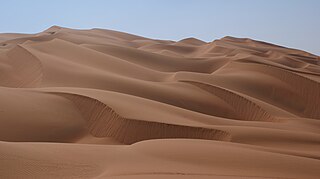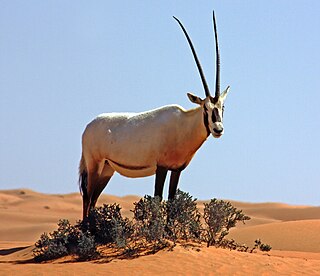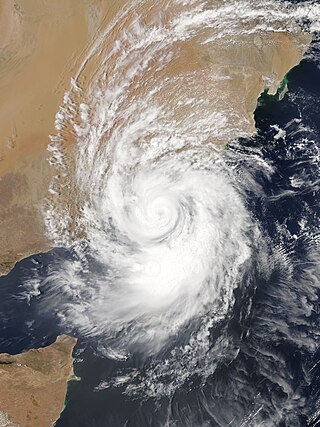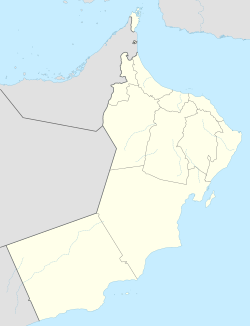
Oman is a country on the southeast coast of the Arabian Peninsula, situated in West Asia, bordering the Arabian Sea, Gulf of Oman, and Persian Gulf, between Yemen and the United Arab Emirates (UAE). The coast of Oman was an important part in the Omani empire and sultanate.

The Arabian Desert is a vast desert wilderness in West Asia that occupies almost the entire Arabian Peninsula with an area of 2,330,000 square kilometers (900,000 sq mi). It stretches from Yemen to the Persian Gulf and Oman to Jordan and Iraq. It is the fourth largest desert in the world and the largest in Asia. At its center is Ar-Rub' al-Khali, one of the largest continuous bodies of sand in the world. It is an extension of the Sahara Desert.

The sand cat is a small wild cat that inhabits sandy and stony deserts far from water sources. With its sandy to light grey fur, it is well camouflaged in a desert environment. Its head-and-body length ranges from 39–52 cm (15–20 in) with a 23–31 cm (9.1–12.2 in) long tail. Its 5–7 cm (2.0–2.8 in) short ears are set low on the sides of the head, aiding detection of prey moving underground. The long hair covering the soles of its paws insulates its pads against the extreme temperatures found in deserts.

The Rub' al Khali or Empty Quarter is a desert encompassing most of the southern third of the Arabian Peninsula. The desert covers some 650,000 km2 (250,000 sq mi) including parts of Saudi Arabia, Oman, the United Arab Emirates, and Yemen. It is part of the larger Arabian Desert.

The Dhofar Governorate is the largest of the 11 governorates in the Sultanate of Oman in terms of area. It lies in southern Oman, on the eastern border with Yemen's Al Mahrah Governorate and the southern border with Saudi Arabia's Eastern Province. It is a rather mountainous area that covers 99,300 km2 (38,300 sq mi) and had a population of 416,458 in the 2020 census. Salalah is the largest city and capital of the governorate. Historically, the region was a source of frankincense. The local dialect of Arabic is Dhofari Arabic, which is distinct from that used in the rest of Oman and in Yemen.

Salalah is the capital and largest city of the southern Omani governorate of Dhofar. It has a population close to 331,949.

Khareef is a colloquial Arabic term used in Oman, southeastern Yemen, southwestern Saudi Arabia and Sudan for the southeastern monsoon. The monsoon affects Dhofar and Al Mahrah Governorates from about June to early September. During these middle months every year, sufficient cold upwelling develops in near-shore waters of the Arabian Sea to hold sea surface temperatures in the low to mid twenties Celsius, while high twenties prevail further offshore. Warm humid air blowing onshore from the central Arabian Sea passes over that cooler water and is chilled until fog and precipitation condense. Towns such as Salalah depend upon the khareef for their water supply. An annual Khareef festival is held in Salalah to celebrate the monsoon and attracts tourists.
Adam an administrative region in Ad Dakhiliyah, in northeastern Oman.
Al Suwaiq is a coastal wilayah (province) in Al Batinah North Governorate, in northeastern Oman. The province has historically been an economic hub, attracting residents from the surrounding areas, its strategic location facilitating trade and commerce.
The Sharqiya Sands is a region of desert in Oman. The region was named for the Bani Wahiba tribe. Divided between the northern and southern governorates in the Eastern Region. The area is defined by a boundary of 180 kilometers (110 mi) north to south and 80 kilometers (50 mi) east to west, with an area of 12,500 square kilometers (4,800 sq mi). The desert has been of scientific interest since a 1986 expedition by the Royal Geographical Society documented the diversity of the terrain, the flora and fauna, noting 16,000 invertebrates as well as 200 species of other wildlife, including avifauna. They also documented 150 species of native flora.
Qaftat is a village in the Dhofar Governorate of southwestern Oman. It is located in a coastal area amidst mountains facing the Arabian Sea.
A' Sunaynah is a Wilayah (Province) in Al Buraimi Governorate, northeastern Oman. The village contains a substantial area of greenery and is described as "remote, even by Omani standards". A' Sunaynah is known for its traditional camel races as well as textile and weaving industries. The wilaya is reportedly occupied by the Al Nuaimi tribe; in the 1960s the tamimah of the Al Nuaim was reported to be 'Ali ibn Hamuda of the Al Bu Khuraiban division, who lived at Sunainah.
The Khawrs of the Salalah Coast Reserve are a group of eight natural reserves in the Dhofar Governorate of Oman. They consist of lagoons and vary in size from a few hectares to more than one hundred hectares.

Jalan Bani Bu Ali is a commercial town and tourist destination in Oman.

The wildlife of theUnited Arab Emirates is the flora and fauna of the country on the eastern side of the Arabian Peninsula and the southern end of the Persian Gulf. The country offers a variety of habitats for wildlife including the coast, offshore islands, mangrove areas, mudflats, salt pans, sand and gravel plains, sand dunes, mountain slopes, wadis and rocky summits. Because the terrain is so varied, it supports a greater number of species of plants and animals than might be expected in a small country.

The wildlife of Oman is the flora and fauna of this country in the southeastern corner of the Arabian Peninsula, with coasts on the Gulf of Oman and the Arabian Sea. The climate is hot and dry, apart from the southeastern coast, and the country offers a variety of habitats for wildlife including mountains, valleys, deserts, coastal plains and sea coasts.

Extremely Severe Cyclonic Storm Mekunu was the strongest storm to strike Oman's Dhofar Governorate since 1959. The second named storm of the 2018 North Indian Ocean cyclone season, Mekunu developed out of a low-pressure area on May 21. It gradually intensified, passing east of Socotra on May 23 as a very intense tropical cyclone. On May 25, Mekunu reached its peak intensity. The India Meteorological Department estimated 10 minute sustained winds of 175 km/h (110 mph), making Mekunu an extremely severe cyclonic storm. The American-based Joint Typhoon Warning Center estimated slightly higher 1 minute winds of 185 km/h (115 mph). While at peak intensity, Mekunu made landfall near Raysut, Oman, on May 25. The storm rapidly weakened over land, dissipating on May 27.

The Dhofar Mountains are a mountain range in the southeastern part of the Arabian Peninsula. In a broad sense, they extend from Dhofar Governorate in Oman to Hadhramaut Governorate in Yemen, and are located between the Hajar in the northern part of Oman, and the Sarawat in the western part of Yemen. Otherwise, the range in the eastern part of Yemen, particularly near Mukalla, is referred to as the Hadhramaut or "Mahrat".

Al-Baleed Archaeological Park is an archaeological park located in Al Balīd of Salalah, Dhofar, Oman. It is a part of the Land of Frankincense in the UNESCO World Heritage Site since 2000.













